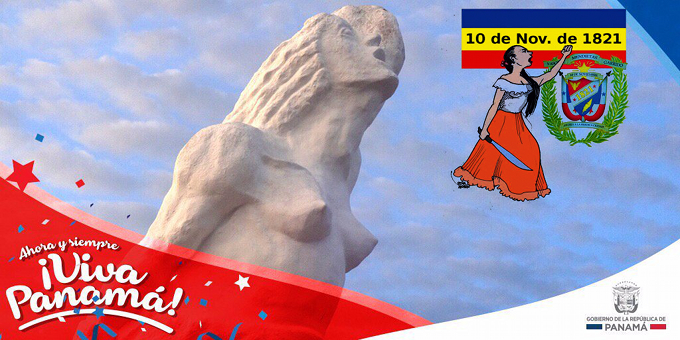Rufina Alfaro, in the official imaginations of Panamanian guys.
Today in legend and history
by Eric Jackson
What Panamanian guy would be so unpatriotic as to question the magnificence of Rufina Alfaro’s tits? Or so sexist as to doubt that she was a machete-wielding badass revolutionary?
Those questions raise deeper historical questions about the suppression and falsification of our history. But given all that, might it actually be the case that the Rufina Alfaro legend is very close to the historical truth?
The legend has it that Rufina Alfaro was a young campesina who would sell vegetables and eggs to the soldiers at the La Villa de Los Santos army base. Using her friendship with the soldiers, it is said that she convinced the troops to rebel against the Spanish crown, a key elements of “El Grito de La Villa de Los Santos” on November 10, 1821.
So, a foxy young lady with a machete, calling out the troops and perhaps threatening to cut the nuts off of those who did not comply?
At the time, all sorts of people had reasons to lie about who did what. There were at the time political prisoners of the Latin American independence movement held on the isthmus. Some of such folks had been executed at Fort San Lorenzo, then a Spanish prison, overlooking the mouth of the Chagres River. Rebellion against Spain was, after all, a capital offense.
It was also quit a popular thing to do. Panama’s place in the Spanish Empire had been as part of the Viceroyalty of New Granada, more or less encompassing today’s Venezuela, Colombia, Ecuador and Panama. Simón Bolívar and a badass Irish and Vene crew, decimated and defeated in Venezuela and driven into the snake-infested swampy boonies, had hacked their way through the bush, scaled the snow-covered Andes and showed up behind Bogota. Taken by surprise, the Spanish troops put up a token bit of resistance but retreated, and their commanders and the viceroy fled. As the rest of the viceroyalty was falling, Panama became the more or less administrative center in exile while great effort was being made to preserve a Spanish presence in Ecuador, from whence to launch a restorationist counteroffensive.
That was apparently not a very attractive thought to demoralized Spanish soldiers stationed in the Azuero boonies.
Nor was being drafted into the army, nor paying extra taxes to support a recolonizing venture, an attractive venture for local farmers.
Back then, the miracle of Panama’s geographical position had worn down to almost nothing. The last trade fair had been almost a century ago and the heyday of that era was even longer gone. The isthmian economy still had a few trade route related components, but this was a provincial backwater that depended of producing things by farming the land or fishing the sea for its livelihood. La Villa de Los Santos and the other provincial towns were there to serve as markets and supply stores for the farmers. In this largely illiterate rural society, forget about much in the way of an administrative bureaucracy. The learned ones, such record keepers and teachers as there were, were concentrated in the Catholic Church. Baptismal certificates were far more common than government birth certificates. It would not be so unusual for a rural midwife or a campesino family to ignore the paperwork.
At the inception of the Spanish Conquest, the Catholic Church was better about these roles. By treaty with the Spanish Empire, these were church obligations that came in exchange for a cut of the loot from the golden kingdoms and farmlands to be conquered, plus land and buildings for the churches. But when Napoleon conquered Spain and put his brother — to this day reviled by Spaniards as Pepe El Borracho — on the throne in Madrid, the old deal more or less became a dead letter. Napoleon was ephemeral, but the attempt to restore the old Church and State order was resisted by colonials who had done well enough without orders from Spain and by a new breed centered around freemasons like Bolívar, San Martín and O’Higgins, men who favored secular government and religious freedom. Meanwhile, even if farther up the hierarchy there were bishops and so forth who looked to restore the old arrangements, down the ranks of the clergy there were people grown accustomed to carrying on without much funding from a decadent and no longer so legitimate state.
So, does the lack of a church or state record of Rufina Alfaro’s existence prove her to be a myth? Probably not. But the lack of records about an Alfaro family in the area is taken as persuasive.
In any case, troops and townspeople rebelled against Spain on November 10, 1821, called a town meeting — cabildo abierto — and mainly at the behest of the local merchants drafted a resolution calling for independence from Spain. That was what the shouting was all about.
A few days later, the priests, bishops, merchants and bureaucrats in Panama City accepted the wisdom of this argument and they declared both independence from Spain and allegiance to Bolívar’s Gran Colombia. For the church is was a new state with which to make new arrangements and that maneuvering was a source of tremendous grief for 19th century Colombia, of which Panama was a part. A lot of people were killed about it.
By the time that Panama separated from Colombia in 1903, the country had been devastated by too many civil wars about which whether the Catholic Church would be the official religion was one of the issues. With independence came deal to exclude priests from government, maintain state support for things like church buildings and catechism in the public schools, and not to talk about the religious history of Panama. Now, more than a century after that we have a country intentionally raised to be ignorant about that and many other parts of our history. And if somewhere in some archive there is a church record about Rufina Alfaro’s existence, it has been neglected.
Contact us by email at fund4thepanamanews@gmail.com
To fend off hackers, organized trolls and other online vandalism, our website comments feature is switched off. Instead, come to our Facebook page to join in the discussion.
These links are interactive — click on the boxes











